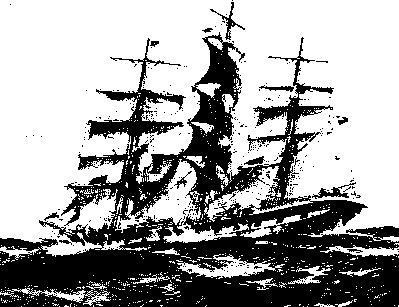 |
FAMOUS SHIPS |
 |
FAMOUS SHIPS |
The "LOCH ETIVE"
This ship is famous for one primary reason - Joseph Conrad served in her as 3rd mate in the earlier period of his sea career. One of Conrad’s most popular books among seamen was "Mirror of the Seas." He refers to the Loch Etive is this book as follows: "The ship was one of those iron wool clippers that the Clyde had floated out in swarms upon the world during the seventh decade of the last century. It was a fine period in shipbuilding, and also, I might say, a period of overmasting. The spars rigged up on the narrow hulls were indeed tall then, and the ship of which I think, with her colored-glass skylight-ends bearing the motto, ‘Let Glasgow Flourish,’ was certainly one of the most heavily-sparred specimens. She was built for hard driving, and unquestionably she got all the driving she could stand." Loch Etive was the fifteenth vessel built by Messrs. J. and A. Inglis for the famous Loch Line of Glasgow, managed by Messrs. Aitken, Lilburn & Co. She was 1,235 tons registered, measuring 226 feet 9 inches in length, 35 feet 9 inches breadth and 21 feet 6 inches depth of hold. She was heavily rigged with a skysail yard at the main. She did carry her canvas well and it was never recorded that she lost a spar of any consequence. In her later years she was cut down to a barque to save expenses.
The Loch Etive’s passages, both outwards and homewards, seem to have averaged about 90 days. Then she suddenly made two outstanding voyages. On October 15th, 1892, she left Glasgow and arrived in Hobson’s Bay on Christmas Day, 70 days out from the Tail of the Bank. Then leaving Melbourne with a wool cargo on January 26th, 1893, she arrived in the Thames on April 29th, 93 days out, being under 6.5 months for the round voyage. At 8 pm on September 23rd, 1893, she sailed from the Clyde for Adelaide, which she reached at 10 am on December 12th, 80 days out.
That old Captain Stuart was still a hustler is evident, for she towed to the powder ground, discharged 20 tons of gunpowder, and berthed at the wharf for discharging on the same afternoon. On the 13th she began discharging 800 tons of cargo; she then took on board 300 tons of lead spelter, towed down the river, and on the 16th dropped her anchor off the Semaphore; sailed on the 17th, and arrived at Melbourne on the 19th. Here she discharged the remainder of her cargo, some 750 tons, and took wool for Antwerp. On his departure, Captain Stuart left Melbourne Heads on January 18th, 1894, but was held up in Bass Straits by light winds for a week. The Horn was passed, 3 miles off, at noon on February 15th, the Equator crossed at noon on March 15th, the Lizard signaled at noon on April 12th, and the ship docked in Antwerp on April 15th, 87 days out.
Captain Stuart was ill, but still sailed again from Glasgow on September 16th. The famous master mariner passed away five days out to sea and was buried at sea - he was 63 years young. He had been 43 years a shipmaster, with the proud record of never having lost a man or a mast overboard. He had been offered command many times of the new steamships, but he always remained faithful to his old windjammer’s. Many of his men had sailed with him for voyage after voyage, and a number of them had reached command after having been not only sea trained, but educated by Captain Stuart. Joseph Conrad was one of those who was in awe of the great man and looked upon his as the beau ideal of a sailor. The first mate, Mr. Wade, took the ship to Adelaide in 98 days. There the command was given to Captain Fishwick, who commanded her from 1895 until 1909.
The Loch Etive had her after-yards and main skysail removed as an economy move in 1904. On November 13th, 1904, she left Glasgow as a barque; passed the Tuskar on the 19h, and crossed the Line on December 12th. The Prime Meridian was crossed on January 2nd, 1905, and the Cape Meridian on January 7th.. The Leeuwin Meridian was crossed on January 27th, and the ship arrived in Port Jackson, only 80 days out. This was a very smart passage to make after being cut down, and the shippers at once decided that her sailing powers had not been spoilt. Right up to 1911 the Loch Etive continued to load cargoes for Adelaide, Melbourne and Sydney. Captain Anderson had succeeded Captain Fishwick. In 1911 the old Loch liner was sold to the French for the paltry sum of 1,350 pounds sterling, and by 1914 she had disappeared from the register.